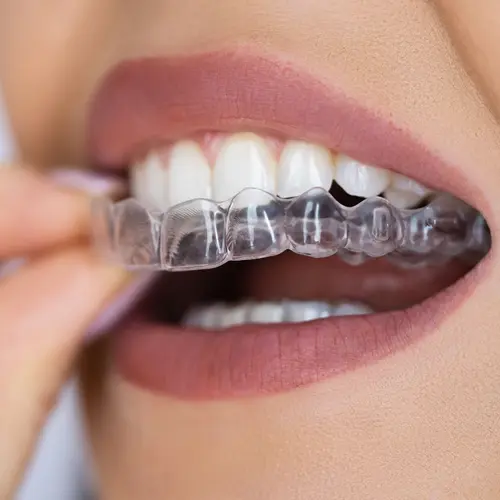When you think of braces, you may imagine the brackets and metal wires that make up traditional braces. But did you know that you may need orthodontic spacers before getting braces? Orthodontic spacers are often used to prepare your mouth for braces.
What Are Orthodontic Spacers?
If you’re concerned about your smile, you may need to see an orthodontist. An orthodontist is different from a dentist. A dentist cleans your teeth, watching for plaque and cavities. An orthodontist specializes in the care of your teeth when it comes to alignment – the arrangement of your teeth in your mouth.
Orthodontists use braces and other orthodontics to address mouth problems, including:
- Overbite
- Underbite
- Crooked teeth
- Crowded teeth
Before you get braces, your orthodontist will want to prepare your mouth for the best possible results. They may use orthodontic spacers to make room for the brackets that will fix braces to your teeth.
Orthodontic spacers are small elastic or metal separators placed between teeth to create gaps. The separators are about a centimeter in diameter. Your orthodontist will place them where needed, after your specific dental needs are figured out.
When spacers are first placed between your teeth, you may feel pain, tenderness, and soreness. This is because the spacers are forcefully moving your teeth. Don’t be concerned. After a few days, the pain and soreness go away.
Spacers are usually in place for one to two weeks. You’ll want to be careful of what foods you eat so that you don’t knock the spacers loose. You may also be advised not to floss between teeth where spacers are located.
How Do Orthodontic Spacers Affect Your Health?
Spacers don’t usually have an immediate impact on your overall health. At first spacers cause discomfort, but the long term health benefits are worth it. This initial discomfort may include:
- Irritation to nerves that cause consistent pain
- Tenderness when you apply pressure to the teeth where spaces are located
- Awkward chewing and discomfort while eating
- Swelling and bleeding is possible if the spacers press against your gums
Soft, cold foods can help to ease the pain and discomfort by providing soothing, numbing relief. If you have concerns about your discomfort or swelling, call your orthodontist. They can ask about your symptoms and decide if there is any cause for concern.
It is still safe and important to brush your teeth, even with spacers in place. Regular brushing won’t disturb them, and it is important for preventing cavities.
Benefits of Orthodontic Spacers
Straight teeth. One goal of braces can be to straighten your teeth. The amount of time you spend wearing your braces is small compared to the rest of your life with a smile that makes you feel confident.
Improved dental health. If you have teeth that are crowded and rubbing together, you’re at a greater risk for cavities and plaque. When teeth are evenly spaced in your mouth, you are able to brush and floss more effectively.
Disadvantages of Orthodontic Spacers
Forbidden foods. There are certain foods to avoid with spacers or braces in place. These foods could cause damage and include:
- Chewy foods, like gum and licorice
- Crunchy foods. like popcorn and pretzels
- Sticky foods, like caramel
- Hard foods, like nuts and pretzels
- Sugary foods, like lollipops and candy
Even healthy foods – such as apples, raw carrots, and corn – may be off-limits if they are difficult to bite down on.
Cost of eating forbidden foods. If you decide to eat some of those forbidden foods, it is possible that your spacers or braces will break. Your orthodontist will need to repair them, costing more time and money.
Decay. When you have braces, it is easier for food to gather, plaque to build up, and cavities to develop. Sugar can cause decay around your braces, leading to cavities and discoloration.
Watching what you eat is one way to prevent damage to your teeth. Regular dental care is also important.
More About Braces
Reasons for needing braces. Dental issues may be caused by a number of things, including:
- Injury to your face or mouth
- Misalignment of your jaw
- Heredity
- Sucking your thumb as a baby or toddler
Many people think that the only purpose of braces is to straighten your teeth. Braces support your overall dental health by:
- Preventing tooth decay and gum disease
- Reducing the chance of tooth loss
- Improving the way you chew
- Improving speech that is affected by bite
- Reducing abnormal wear on your enamel caused by tooth alignment
- Addressing jaw problems that lead to an overbite or underbite
How braces work. There are several types of orthodontic treatments available. Different devices have different goals, and some braces are more effective than others.
Traditional braces have brackets cemented to your teeth that are connected by a thin piece of wire – often prepared for by spacers. After braces are in place, your orthodontist will adjust the wire regularly. This applies pressure and straightens your teeth slowly over time. Sometimes the brackets and wires are placed on the back of your teeth instead of the front, if you don’t want them to show when you smile.
Most people have braces for 1 to 3 years. Once your braces have completed their work, your orthodontist will make a mold of your teeth for a retainer. By sleeping in a retainer, you can maintain the straightening effects of braces.
